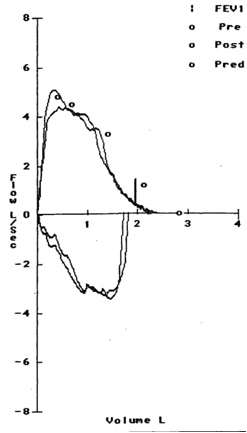
Pulmonary Function Testing
Case 10 Answer
A 53 year-old woman presents with increasing dyspnea on exertion. She denies cough, fevers, hemoptysis, weight loss or sweats. She was previously an active runner but has had to cut back significantly because of her symptoms with exercise. She does note occasional chest pain with exercise but has not had any syncope or palpitations.
Her pulmonary function tests are as follows:
| Pre-Bronchodilator (BD) | Post- BD | ||||
|---|---|---|---|---|---|
| Test | Actual | Predicted | % Predicted | Actual | % Change |
| FVC (L) | 2.38 | 2.87 | 83 | 2.23 | -6 |
| FEV1 (L) | 1.95 | 2.31 | 84 | 1.93 | -1 |
| FEV1/FVC (%) | 82 | 81 | 87 | ||
| RV (L) | 1.69 | 1.58 | 107 | ||
| TLC (L) | 4.26 | 4.36 | 98 | ||
| RV/TLC (%) | 40 | 36 | |||
| DLCO* corr | 9.96 | 23.25 | 43 | ||
| *DLCO is measured in ml/min/mmHg | |||||
Her flow volume loop is as follows:

Case 10 Interpretation
This patient has normal FEV1 and FVC and a preserved FEV1/FVC ratio. She also has a normal total lung capacity. As a result, there is no evidence of either obstructive or restrictive lung disease. The patient does have a reduced DLCO, however, indicating that she has a reduced alveolar-capillary interface for gas exchange. Based on her DLCO of 43% predicted, she would be labeled as having a “moderate” gas exchange abnormality.
The finding of an isolated decreased in the DLCO (i.e. normal spirometry and lung volumes) is highly suggestive of a pulmonary vascular process such as pulmonary hypertension. This patient was, in fact, found to have pulmonary hypertension due to chronic thromboembolic disease.
UW School of Medicine : School of Medicine Mission
Copyright and Disclaimer : Credits and Acknowledgements